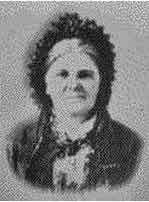Mary was baptised on 29 April 1804 at Trinity. Her parents were Joshua Billot and Elizabeth Adeline Gibaut. Marie's birth date is given as 8 April 1801 in a history written about their daughter, Fanny Mary Ann.
Simple life
The Romerils lived a simple and industrious life. Francis worked as a shoemaker. Mary ran a store with a bakery department. They also kept cows. They were parents of 11 children: Marie Marguerite (Mary), Francois Thomas, John Abraham, and George baptised at St John; Charles and Ann Mary baptised at Trinity; and Jane, Fanny Mary Ann, Ann, Charles Abraham, and Sophie Jeanne baptised at Grouville.
The children helped with the cows and went to the beach to gather oysters, which had been washed in with the tide. They gathered them in large baskets carried on their arms. They had little chance for education, quitting to earn a living as soon as they were able. They were a very happy and affectionate family, religiously inclined. They spoke the French language, although they were taught French and English in school. The school was sponsored by the Methodist Church, of which they were all members until the year 1849.
At this time, they heard and embraced the Gospel of Jesus Christ of Latter Day Saints. The elders were always welcomed into their home. Some who visited them were Richard Treasder, Curtis Bolton, John Pack, Dunber Fornax, and John Taylor, who later became president of the Church. Dunber Fornax and John Taylor helped in the family's conversion.
Many people were prejudiced against the Latter Day Saints and Elder John Taylor was imprisoned in France. Through the influence and collection of a large amount of money by Mary Romeril he was released. He was very friendly with the family and made his home with them while there. They lived in a very old stone house with huge oak beams across the ceilings. Pillars, stairways, and banisters were also of oak but were decaying with age. Ivy covered most of the outer walls, but cherries and apricots bearing an abundance of fruit were trained up the side of one of the walls.
After joining the church, four years were spent in planning and saving to make ready for the long journey to Utah. Great chests were made which they packed full of clothes and other necessities. Mary's family were well-to-do and tried to convince some of the children to stay with them to share in the family inheritance. They had objected to Mary's marriage to Francois because he was poor, and they objected to the family joining this new church. None of the children chose to stay.
Across the Atlantic
In the early part of April 1855, they left for Liverpool, England with 70 others from Jersey. In all, 431 Mormons left Liverpool on board the ship Chimborazo on 17 April 1855 under the direction of Edward Stevenson. Landing at Philadelphia on 21 May 1855, they proceeded by train to St Louis, Missouri to be outfitted with ox-teams and wagons for the trip across the plains.
They journeyed on the long, wearisome, trail sometimes walking, sometimes driving the stubborn oxen shouting "Whoa! Gee! Ha!" and invariably the oxen would go just the reverse from where they were supposed to go. Sometimes the oxen would stampede, running and pulling the wagon over bumps and hollows. Sometimes the children would drive the oxen for an aged couple in the same train.
When the evening came and the great corral was formed with the wagons, the older children went in search of wood with which to make the campfires. When wood could not be found, they used buffalo chips, which made a good fire. When the supper was over and the things put by, the Captain would call everybody to the corral for a dance in the corral to which every man, woman and child must go. Soon, by the music of a violin or any other instrument, they had the people one and all dancing either in a quadrille or reel until all thoughts of being tired had disappeared and everyone was laughing and chatting happily as in the morning.
Sometimes members of the camp would dance in their bare feet to save their shoes. They arrived at Great Salt Lake City on November 12, 1855. As they arrived too late in the year to prepare for winter, the family was forced to endure many hardships. Though they had plenty of money and clothes, they needed food. Francis paid ten dollars for a sack of flour, which they rationed out, giving to each one a little bit each day. They dug roots with many other families to obtain food. The children used to go to the fields and dig for heads that might be left from the harvest.
Francis stayed with his occupation as shoemaker. The family settled in Bingham's Fort, in Ogden, Utah. Some of the older children were married. George came from St Louis in 1861. Fanny Mary Ann found employment as cook and housekeeper for the Joseph Young family in 1859. She married a man from the south and went back with him to Alabama. Jane married George Pierce in 1864.
Francis' wife, Mary, died on 11 May 1866, just 11 years after entering the valley. She was buried in the City Cemetery, in Ogden, in the Pierce lots. Their youngest child, Sophie was married in 1868. Fannie's husband was killed in an accident; Francis sent for her and her children to come back to live with him. They arrived in Ogden in February 1874. La Pierre, the children's paternal grandfather, came with them, but died the following April. Francis attended the Lynne Ward (or Bingham's Fort as it was called). He died on 9 October 1875 and was buried next to his wife in the Ogden City Cemetery.
